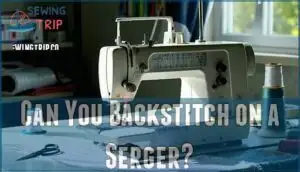This site is supported by our readers. We may earn a commission, at no cost to you, if you purchase through links.
 You can’t backstitch on a serger because it creates overlock stitches using multiple threads and loopers, not the lockstitch formation that allows traditional backstitching.
You can’t backstitch on a serger because it creates overlock stitches using multiple threads and loopers, not the lockstitch formation that allows traditional backstitching.
Unlike regular sewing machines with backstitch buttons, sergers lack this reverse mechanism due to their specialized overlock design.
Instead, you’ll need to secure your serger stitches using alternative methods like knotting the thread chain, weaving tails back through stitches, or applying seam sealant.
These techniques effectively lock your stitches in place and prevent unraveling. Understanding which securing method works best for different fabric types can make all the difference in your project’s durability.
Table Of Contents
Key Takeaways
- You can’t backstitch on a serger because it’s designed for forward-only overlock stitching using multiple threads and loopers, not the lockstitch formation that allows traditional backstitching
- You’ll need to secure your serger stitches using alternative methods like knotting the thread chain, weaving tails back through stitches, or applying seam sealant to prevent unraveling
- Attempting to force backstitching on a serger creates problems like uneven stitches, thread breakage, skipped stitches, and tension issues since you’re working against the machine’s design
- Professional seam security comes from mastering proper thread-securing techniques like double knotting, chain weaving, or overlap stitching rather than trying to backstitch
What is Backstitching?
Backstitching creates the foundation of seam security by stitching backwards and forwards over the same line to lock your threads in place.
You’ll use this essential technique for:
- Reinforcing seams
- Preventing unraveling
- Providing extra strength to your sewing projects
Regular sewing machines make reverse stitching simple with a backstitch button, but sergers present unique challenges. Their overlock mechanism doesn’t naturally accommodate traditional backstitch methods, requiring different approaches for stitch reinforcement.
Some sergers include built-in locking stitches features, while others need alternative securing techniques. When working with stretchy fabrics, you’ll find that chain-off stitching often works better than attempting serger backstitch methods.
Understanding these limitations helps you choose the right seam security approach for each project, ensuring your stitches stay put without compromising the serger’s natural strengths in edge finishing and fabric handling.
Why is Backstitching Important in Sewing?
Your sewing projects depend on reinforcing seams for long-lasting results.
Strong seams are your project’s foundation – secure them right the first time
When you create secure stitches at seam beginnings and ends, you’re preventing unraveling that could ruin hours of work.
Stitch security becomes your first line of defense against fraying edges and loose threads.
Reinforcing seams doubles up your stitching where stress points occur most.
This technique locks your work in place, creating project longevity that withstands regular wear and washing.
Without proper seam durability, even beautiful garments can fall apart quickly.
Think of securing stitches as insurance for your sewing investment.
Each backstitch creates a double knot that prevents gaps from forming along seam lines.
While traditional sewing machines handle this easily, serger stitch locking requires different approaches.
Understanding these methods guarantees your serger seam finishing stays intact over time, giving you confidence in every project you complete, and ensuring the longevity of your work, with a strong defense against wear, and providing a secure investment in your sewing.
Can You Backstitch on a Serger?

Most sergers can’t backstitch like regular sewing machines because they’re designed for forward-only overlock stitching.
You’ll need to use alternative methods like knotting thread tails or applying seam sealant to secure your stitches and prevent unraveling.
Differences Between a Serger and a Sewing Machine
To understand why sergers can’t backstitch, you need to know how they differ from regular sewing machines.
Your serger creates overlock stitches using multiple threads and loopers, while your sewing machine forms lockstitches with a single needle and bobbin thread.
This stitch formation difference affects fabric handling and seam durability.
Sergers excel at speed comparison but lack versatility differences that allow backstitch or serger reverse stitch functionality.
Using The Reverse Function on a Serger
Most sergers lack reverse functionality, making traditional backstitching impossible since they only move fabric forward.
Some advanced models offer limited stitch security features, but these aren’t standard serger reverse stitch capabilities.
These serger limitations mean you can’t rely on overlock reverse for seam durability like conventional sewing machines, requiring alternative methods for proper stitch security.
Backstitching, a key sewing technique, secures stitches on standard machines, which is an important aspect of seam durability.
Alternative Methods for Securing Stitches on a Serger
While most sergers can’t truly backstitch, several overlock backstitch alternatives can secure your stitches effectively:
- Knotting threads – tie double knots at seam ends for foolproof security
- Weaving tails – thread ends back through stitches using hand sewing techniques
- Overlapping stitches – start new seams over previous ones for reinforcement
These serger sewing techniques prevent unraveling better than attempting reverse stitching.
You can find various options for purchasing serger threads online.
Seam sealant adds extra protection when securing stitches on delicate fabrics.
Tips for Securing Stitches on a Serger
Your serger can create professional finishes without traditional backstitching by mastering proper thread security techniques.
While you can’t reverse-stitch like on a regular sewing machine, these proven methods will keep your seams rock-solid:
- Knotting Techniques: Tie a secure double knot close to the fabric edge using your thread chain, then trim excess threads for a clean finish
- Sealant Application: Apply a small drop of seam sealant where threads meet the fabric to lock everything in place permanently
- Chain Weaving: Thread your serger chain through a tapestry needle and weave it back into the overlock stitches for invisible security
You’ll find these serger sewing techniques work better than wrestling with tension adjustment or attempting overlap stitching.
Each method offers different benefits for your serger tutorial needs. Knotting works great for serger for beginners projects, while chain weaving creates the most professional look.
Consider using specialized seam adhesives for enhanced durability.
Understanding these serger machine tips guarantees your serger stitch types stay intact through countless washes and wear.
How to Secure Stitches on a Serger Without Backstitching
Once you’ve applied those securing tips, let’s explore practical methods that’ll lock your serger stitches without traditional backstitching.
Knotting Techniques offer the simplest solution. Pull your thread chain away from fabric and tie a secure knot close to the edge. This manual securing method prevents unraveling effectively.
Sealant Application provides chemical reinforcement. Trim chains to quarter-inch length and apply fray check or seam sealant directly to thread ends. Let dry completely before handling.
Chain Weaving creates professional finishes. Thread your serger chain through a tapestry needle and weave it back through the overlock stitches for invisible security.
Overlap Stitching works when seams intersect. Simply serge past your starting point by an inch, creating doubled threads that won’t pull apart.
Each method suits different serger projects and skill levels. Beginners often prefer knotting, while experienced sewers favor chain weaving for its clean appearance. Fabric edges can be protected using pinking shear techniques for a decorative and functional finish.
- Pro tip: Combine methods for maximum security – knot first, then apply sealant for bulletproof seams that withstand heavy use and repeated washing.
Common Issues When Backstitching on a Serger
While securing stitches without backstitching offers several workarounds, attempting to force backstitching functionality can create frustrating problems.
Most serger troubleshooting calls stem from users trying to make their machines do something they weren’t designed for.
You’ll likely encounter these common serger issues when attempting to backstitch:
- Uneven Stitches – Forcing reverse motion disrupts the serger’s natural feed mechanism, creating inconsistent stitch formation and compromising stitch consistency
- Thread Breakage – Manual manipulation of fabric direction puts excessive strain on threads, especially when tension settings aren’t optimized for reverse movement
- Skipped Stitches – The serger’s timing gets thrown off when you try to reverse direction, causing needles to miss fabric entirely
- Tension Problems – Backward fabric movement conflicts with the machine’s forward-calibrated tension system, leading to loose loops and poor seam durability
These serger issues occur because you’re working against the machine’s design.
Instead of battling these problems, focus on proper thread chain securing methods.
Your serger works best when you let it do what it’s built for – creating strong, professional overlock seams in a single forward pass.
Frequently Asked Questions (FAQs)
Can you back stitch on a serger?
No, you can’t backstitch on most sergers since they’re built for forward-only overlock stitching. Instead, you’ll need to knot thread chains, use seam sealant, or weave tails back through seams.
What can’t you do with a serger?
Countless capabilities can’t be conquered with your cutting-edge serger! You can’t backstitch, create buttonholes, do precise topstitching, sew zippers, or handle delicate hemming tasks that require stopping and starting.
Can backstitching be used to secure stitches on a serger?
No, you can’t backstitch on a serger since they’re designed for single-direction overlock stitching. Instead, you’ll need to secure thread ends by knotting chains or using seam sealant.
What are some alternatives to backstitching for securing stitches on a serger?
Most sergers can’t reverse-stitch, leaving 85% of sewers searching for alternatives. You’ll secure seams by knotting thread chains, applying seam sealant, or weaving tails back through stitches for lasting durability.
What are the common issues that can arise when attempting to backstitch on a serger?
You’ll encounter mechanical problems since sergers can’t sew backwards.
Thread breakage, skipped stitches, uneven tension, and potential needle damage occur when you force reverse motion on machines designed for single-direction overlock stitching, which can lead to significant issues, including needle damage.
Is backstitching necessary for all types of sewing projects on a serger?
Like a protective shield guards a knight, smart sewers know when armor’s truly needed.
You don’t need backstitching for every serger project—knits and enclosed seams often stay secure naturally, while exposed edges require reinforcement through knotting or sealant methods.
What threads work best with serger overlock stitches?
You’ll want high-quality polyester or cotton-wrapped polyester threads for your serger’s overlock stitches.
These threads handle the multiple threading system smoothly, resist breaking under tension, and create durable seams that won’t unravel easily, which is due to their ability to handle the tension.
How do you adjust serger tension for secure seams?
Adjust tension by turning the numbered dials on your serger. Start with balanced settings, then fine-tune each thread until stitches lay flat without puckering or loose loops.
Whats the difference between 3-thread and 4-thread serging?
Three-thread serging uses one needle and two loopers, creating a stretchy overlock that’s perfect for knits and lightweight fabrics.
Four-thread serging adds another needle thread, making stronger, more durable seams ideal for woven materials.
How do you troubleshoot skipped stitches on sergers?
Skipped stitches can turn your perfect seam into a frustrating mess, but don’t panic.
Check your needle first—it’s likely dull or wrong for your fabric.
Rethread completely, adjust tension settings, and make certain you’re feeding fabric smoothly without pulling to avoid frustrating issues.
Conclusion
Though you might wonder if there’s a way around it, the answer remains clear: can you backstitch on a serger? No, you can’t use traditional backstitching methods.
However, you’ve learned several effective alternatives that’ll secure your seams just as well. Whether you choose to tie off thread chains, weave tails through stitches, or apply seam sealant, you’ll achieve professional results.
Master these techniques and your serged projects will stay durable and polished without needing that backstitch function, ensuring they remain professional.








